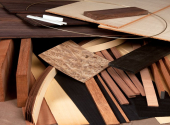
5 First Steps to the Guitar and How to Finally Start Playing
The following lines were not written by a guitar teacher, nor by a legend endowed with divine powers. They're from a guitarist who found his own path to the instrument and has been following it (or it has been following him) for nearly a quarter of a century. There are other paths and other advice—and don't be afraid, whenever you do start, to follow those. These five tips are not ranked by importance or order—I even think they apply to more advanced guitarists as well.
1. Play, play, play. Then deal with the rest
People often ask me what instrument to buy for a beginner. Where to get sheet music, and if they need to be able to read it. Which instruction books are appropriate. Who to turn to for guitar lessons. Over the years, my answer has always been the same—if you're starting out, it's like running. Take the shoes that fit you best at that moment and just run. Once you're doing this activity regularly and you've run a few miles, you'll be better able to judge for yourself what fits and what doesn't. But since I suspect the overlap between marathoners and guitarists to be close to zero, let’s get back to the strings. The instrument should be comfortable for you. That is, it should be at least somewhat tuneable (that usually rules out your great-grandpa's old guitars), it shouldn't have too hard strings (like the guitar from that uncle who plays with his drinking buddies around the campfire every Friday), it should fit (if you have small hands, avoid wide necks if possible).
There is no point in overthinking your very first guitar, 100-150 dollars should suffice for your first instrument (if you insist on a new one). Even a slightly more experienced friend can advise you on how to choose one, even if he wouldn't be able to pick an instrument for an advanced player. Ten buck should be enough for a basic tuner. Preferably, you should visit a shop where there are a lot of guitars you can try; your hands know best.
I know that Slash in leather pants with a Gibson is sexier than Willie Nelson with a Spanish guitar, but for beginners I do recommend an acoustic guitar (can be western, it doesn't have to be classical). That's because that way you'll just focus on the main thing, which is learning the basics of playing the instrument. For that, you don't need distortion, effects, cables, or any of that stuff. If you master this well, the transition to electric isn't that hard, although you will have to learn a few more tricks. You don't want to run a marathon right away when you put on your first pair of running shoes. Playing with a pick is a fine option, but it's not a necessity–experiment. With and without a pick, with a soft pick (which is easier) or a hard one (which may sound better). 9-gauge strings should be just about right.
2. Play with someone. And make mistakes
Start with songs you like. Nowadays, it's not hard to find chords and tutorial videos on the internet. The downside is that it's very tempting to spend all your time surfing instead of playing the guitar. And clicking your mouse button is not the way to progress. If you're learning chords, it's best to pick up any songbook whatsoever that includes chord diagrams and your favorite songs. You don't need YouTube or the internet at all. You just need to learn from the pictures how to grab and change those chords.
It may not be cool anymore to go to a campfire with a guitar (I mean, I graduated in 1981), but playing somewhere with a friend who's been playing for two years is pretty cool—you learn with your eyes. Usually this means that both of you will be simply playing exactly the same thing, but that's okay. It's got to be fun, those fingers can get pretty sore. Some people get sore from mistakes too, but don't worry about those—we know all those proverbs where those before us have figured out that mistakes are part of life. You are playing guitar, you are not operating on a newborn's heart, so take it easy. Of course you also can party at home with your recordings. It's good for your rhythm, and it's a stress-free way of learning the things you enjoy.
3. Consult the people around you. Once you have completed the first steps
You already know ten songs and three or four chords? Okay, it's time to check if you aren't doing something wrong. While there are many ways to technically play guitar, and even among masters you'll find different techniques (left hand position, pick hold), some things will simply inhibit you. Most of the time it's a spastic right hand movement, a bad pick hold, or an improperly positioned left thumb. Your guitar teacher can help you with this, but so can YouTube. It's not rocket science, even if it might seem that way.
I recommend trying different ways and then picking the one that works best for you. While it's unpleasant to relearn your own guitar habits (after four years of playing, I relearned how to hold a pick, that was no picnic), give yourself some time to get to know what you're comfortable with before you start messing around. I definitely don't recommend watching hours of videos before you even start playing. I can recommend videos by Tomislav Zvardon, Honza Homola, Tomas Valasek or Mark Šmaus. Each one goes about it a little differently, but for a basic overview they're all fine.
4. Listen. To yourself and to others
All the time I've spent playing in bands I've been surprised at how little musicians listen to music. It's no coincidence that among the favorite records of good guitarists you'll often find classical, jazz, blues and metal. Drop your preconceptions and be open-minded. But most importantly, whatever you listen to should transcend the mainstream view (no offence!). Consider what it is that you like in a song, why this particular guitarist sounds different from the others, that—in addition to playing regularly—is what will keep you moving forward all your life. After all, it's nice to discuss this after a rehearsal with your bandmates. I think the genuine joy of listening then makes the often rocky road of trying to play it like your idol a lot smoother.
The above applies to yourself as well. You should be able to listen to yourself (even if maybe you don't have a band right now)—what works, what doesn't, what do I like. This will come in handy much later on in your guitar journey when you're further down the road inventing your own songs, guitar parts, learning musical notes, or practicing with a metronome. And even if you're just practicing with a recording of a favorite song, it's important to have a good understanding of what it is you're doing on the guitar yourself.
5. Don't chuck the guitar in the trash. There will always be someone better than you
Perfect is the enemy of good. Or in other words, do the best you can at this moment. I've never known a guitarist who hasn't experienced the feeling of selling/burying/burning a guitar because someone else plays it better. Eventually even the pros will admit it to you. Coming to terms with the fact that someone plays better is the foundation of successfully navigating the guitar world, but it can take time. Then dealing with your own ego (and well, other people's egos too) in a band is a separate chapter. But more on that another time. For now, just this: when this fifth point gets to you, take a breather, get some sleep, and take it easy on points one through four.
Have a smooth journey down the fingerboard!
Are you at the start of your guitar journey? Tell us all about it in the comments below.
If you have found an error or typo in the article, please let us know by e-mail info@insounder.org.





